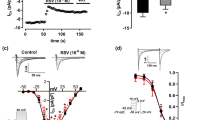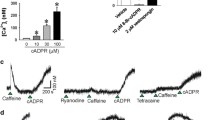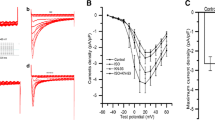Abstract
Modulation of Ca2+ homoeostasis in cardiac myocytes plays a major role in beat-to-beat regulation of heart function. Previous studies suggest that sphingosine-1-phosphate (S1P), a biologically active sphingomyelin metabolite, regulates Ca2+ handling in cardiac myocytes, but the underlying mechanism is unclear. In the present study, we tested the hypothesis that S1P-induced functional alteration of intracellular Ca2+ handling includes the L-type calcium channel current (ICa,L) via a signalling pathway involving P21-activated kinase 1 (Pak1). Our results show that, in rat ventricular myocytes, S1P (100 nM) does not affect the basal activity of ICa,L but is able to partially reverse the effect of the β-adrenergic agonist Isoproterenol (ISO, 100 nM) on ICa,L. S1P (25 nM) also significantly prevents ISO (5 nM)-induced Ca2+ waves and diastolic Ca2+ release in these cells. Our further molecular characterisation demonstrates that Pak1 activity is increased in myocytes treated with S1P (25 nM) compared with those myocytes without treatment of S1P. By immunoprecipitation we demonstrate that Pak1 and protein phosphatase 2A (PP2A) are associated in ventricular tissue indicating their functional interaction. Thus the results indicate that S1P attenuates β-adrenergic stress-induced alteration of intracellular Ca2+ release and L-type Ca2+ channel current at least in part via Pak1–PP2A-mediated signalling.








Similar content being viewed by others
References
Means CK, Brown JH (2009) Sphingosine-1-phosphate receptor signalling in the heart. Cardiovasc Res 82:193–200. doi:10.1093/cvr/cvp086
Payne SG, Milstien S, Spiegel S (2002) Sphingosine-1-phosphate: dual messenger functions. FEBS Lett 531:54–57
Pyne S, Pyne NJ (2000) Sphingosine 1-phosphate signalling in mammalian cells. Biochem J 349:385–402
Spiegel S, Milstien S (2003) Exogenous and intracellularly generated sphingosine 1-phosphate can regulate cellular processes by divergent pathways. Biochem Soc Trans 31:1216–1219. doi:10.1042/bst0311216
Ishii I, Friedman B, Ye X, Kawamura S, McGiffert C, Contos JJ, Kingsbury MA, Zhang G, Brown JH, Chun J (2001) Selective loss of sphingosine 1-phosphate signaling with no obvious phenotypic abnormality in mice lacking its G protein-coupled receptor, LP(B3)/EDG-3. J Biol Chem 276:33697–33704. doi:10.1074/jbc.M104441200
Zhang G, Contos JJ, Weiner JA, Fukushima N, Chun J (1999) Comparative analysis of three murine G-protein coupled receptors activated by sphingosine-1-phosphate. Gene 227:89–99
Graler MH, Bernhardt G, Lipp M (1998) EDG6, a novel G-protein-coupled receptor related to receptors for bioactive lysophospholipids, is specifically expressed in lymphoid tissue. Genomics 53:164–169. doi:10.1006/geno.1998.5491
Im DS, Heise CE, Ancellin N, O’Dowd BF, Shei GJ, Heavens RP, Rigby MR, Hla T, Mandala S, McAllister G, George SR, Lynch KR (2000) Characterization of a novel sphingosine 1-phosphate receptor, Edg-8. J Biol Chem 275:14281–14286
Landeen LK, Dederko DA, Kondo CS, Hu BS, Aroonsakool N, Haga JH, Giles WR (2008) Mechanisms of the negative inotropic effects of sphingosine-1-phosphate on adult mouse ventricular myocytes. Am J Physiol Heart Circ Physiol 294:H736–H749. doi:10.1152/ajpheart.00316.2007
Egom EE, Ke Y, Musa H, Mohamed TM, Wang T, Cartwright E, Solaro RJ, Lei M (2010) FTY720 prevents ischemia/reperfusion injury-associated arrhythmias in an ex vivo rat heart model via activation of Pak1/Akt signaling. J Mol Cell Cardiol 48:406–414. doi:10.1016/j.yjmcc.2009.10.009
Egom EE, Mohamed TM, Mamas MA, Shi Y, Liu W, Chirico D, Stringer SE, Ke Y, Shaheen M, Wang T, Chacko S, Wang X, Solaro RJ, Fath-Ordoubadi F, Cartwright EJ, Lei M (2011) Activation of Pak1/Akt/eNOS signaling following sphingosine-1-phosphate release as part of a mechanism protecting cardiomyocytes against ischemic cell injury. Am J Physiol Heart Circ Physiol 301:H1487–H1495. doi:10.1152/ajpheart.01003.2010
Clair T, Aoki J, Koh E, Bandle RW, Nam SW, Ptaszynska MM, Mills GB, Schiffmann E, Liotta LA, Stracke ML (2003) Autotaxin hydrolyzes sphingosylphosphorylcholine to produce the regulator of migration, sphingosine-1-phosphate. Cancer Res 63:5446–5453
Ke Y, Wang L, Pyle WG, de Tombe PP, Solaro RJ (2004) Intracellular localization and functional effects of P21-activated kinase-1 (Pak1) in cardiac myocytes. Circ Res 94:194–200. doi:10.1161/01.RES.0000111522.02730.56
Ke Y, Lei M, Collins TP, Rakovic S, Mattick PA, Yamasaki M, Brodie MS, Terrar DA, Solaro RJ (2007) Regulation of L-type calcium channel and delayed rectifier potassium channel activity by p21-activated kinase-1 in guinea pig sinoatrial node pacemaker cells. Circ Res 100:1317–1327. doi:10.1161/01.RES.0000266742.51389.a4
Sheehan KA, Ke Y, Wolska BM, Solaro RJ (2009) Expression of active p21-activated kinase-1 induces Ca2+ flux modification with altered regulatory protein phosphorylation in cardiac myocytes. Am J Physiol Cell Physiol 296:C47–C58. doi:10.1152/ajpcell.00012.2008
Egom EE, Ke Y, Musa H, Mohamed TM, Wang T, Cartwright E, Solaro RJ, Lei M (2010) FTY720 prevents ischemia/reperfusion injury-associated arrhythmias in an ex vivo rat heart model via activation of Pak1/Akt signaling. J Mol Cell Cardiol 48:406–414. doi:10.1016/j.yjmcc.2009.10.009
Mazurais D, Robert P, Gout B, Berrebi-Bertrand I, Laville MP, Calmels T (2002) Cell type-specific localization of human cardiac S1P receptors. J Histochem Cytochem 50:661–670
Himmel HM, Meyer Zu Heringdorf D, Graf E, Dobrev D, Kortner A, Schuler S, Jakobs KH, Ravens U (2000) Evidence for Edg-3 receptor-mediated activation of I(K.ACh) by sphingosine-1-phosphate in human atrial cardiomyocytes. Mol Pharmacol 58:449–454
Nakajima N, Cavalli AL, Biral D, Glembotski CC, McDonough PM, Ho PD, Betto R, Sandona D, Palade PT, Dettbarn CA, Klepper RE, Sabbadini RA (2000) Expression and characterization of Edg-1 receptors in rat cardiomyocytes: calcium deregulation in response to sphingosine 1-phosphate. Eur J Biochem 267:5679–5686
Liu SJ, Kennedy RH (2003) Positive inotropic effect of ceramide in adult ventricular myocytes: mechanisms dissociated from its reduction in Ca2+ influx. Am J Physiol Heart Circ Physiol 285:H735–H744. doi:10.1152/ajpheart.01098.2002
Relling DP, Hintz KK, Ren J (2003) Acute exposure of ceramide enhances cardiac contractile function in isolated ventricular myocytes. Br J Pharmacol 140:1163–1168. doi:10.1038/sj.bjp.0705510
Guo J, MacDonell KL, Giles WR (1999) Effects of sphingosine 1-phosphate on pacemaker activity in rabbit sino-atrial node cells. Pflugers Arch 438:642–648
Oral H, Dorn GW 2nd, Mann DL (1997) Sphingosine mediates the immediate negative inotropic effects of tumor necrosis factor-alpha in the adult mammalian cardiac myocyte. J Biol Chem 272:4836–4842
Liu Y, Wada R, Yamashita T, Mi Y, Deng CX, Hobson JP, Rosenfeldt HM, Nava VE, Chae SS, Lee MJ, Liu CH, Hla T, Spiegel S, Proia RL (2000) Edg-1, the G protein-coupled receptor for sphingosine-1-phosphate, is essential for vascular maturation. J Clin Invest 106:951–961. doi:10.1172/JCI10905
Ancellin N, Hla T (1999) Differential pharmacological properties and signal transduction of the sphingosine 1-phosphate receptors EDG-1, EDG-3, and EDG-5. J Biol Chem 274:18997–19002
Okamoto H, Takuwa N, Yatomi Y, Gonda K, Shigematsu H, Takuwa Y (1999) EDG3 is a functional receptor specific for sphingosine 1-phosphate and sphingosylphosphorylcholine with signaling characteristics distinct from EDG1 and AGR16. Biochem Biophys Res Commun 260:203–208. doi:10.1006/bbrc.1999.0886
Taha TA, Argraves KM, Obeid LM (2004) Sphingosine-1-phosphate receptors: receptor specificity versus functional redundancy. Biochim Biophys Acta 1682:48–55. doi:10.1016/j.bbalip.2004.01.006
Bokoch GM (2003) Biology of the p21-activated kinases. Annu Rev Biochem 72:743–781. doi:10.1146/annurev.biochem.72.121801.161742
Hofmann C, Shepelev M, Chernoff J (2004) The genetics of Pak. J Cell Sci 117:4343–4354. doi:10.1242/jcs.01392
Guo D, Tan YC, Wang D, Madhusoodanan KS, Zheng Y, Maack T, Zhang JJ, Huang XY (2007) A Rac-cGMP signaling pathway. Cell 128:341–355. doi:10.1016/j.cell.2006.11.048
Lucas KA, Pitari GM, Kazerounian S, Ruiz-Stewart I, Park J, Schulz S, Chepenik KP, Waldman SA (2000) Guanylyl cyclases and signaling by cyclic GMP. Pharmacol Rev 52:375–414
Wang Y, Tsui H, Bolton EL, Wang X, Huang CL, Solaro RJ, Ke Y, Lei M (2015) Novel insights into mechanisms for Pak1-mediated regulation of cardiac Ca(2+) homeostasis. Front Physiol 6:76. doi:10.3389/fphys.2015.00076
Acknowledgement
The work was supported by the Medical Research Council (G10002647: Dr Lei), the British Heart Foundation (PG11/59/29006, PG/12/21/29473: Dr. Lei).
Author information
Authors and Affiliations
Corresponding authors
Ethics declarations
Conflict of interest
On behalf of all authors, the corresponding author states that there is no conflict of interest.
Rights and permissions
About this article
Cite this article
Egom, E.EA., Bae, J.S., Capel, R. et al. Effect of sphingosine-1-phosphate on L-type calcium current and Ca2+ transient in rat ventricular myocytes. Mol Cell Biochem 419, 83–92 (2016). https://doi.org/10.1007/s11010-016-2752-8
Received:
Accepted:
Published:
Issue Date:
DOI: https://doi.org/10.1007/s11010-016-2752-8




